



Label Rouge: Pasture-Based Poultry Production in France
Pasture-raised poultry is increasingly popular in the United States. American farmers and small companies can benefit from studying the French Label Rouge programme, write Anne Fanatico and Holly Born, NCAT Agriculture Specialists. Started as a grassroots movement, the programme now commands 33 per cent of the French poultry market and it has helped boost incomes for small farmers.Introduction
Pasture-raised poultry is the leading product in a programme in France called 'Label Rouge'. This programme provides premium products to consumers, increases farmer income and strengthens rural development. It consists of many regional producer- oriented alliances, called 'filieres', which produce and market their own branded products under a common label. A third-party certification programme ensures that strict standards are being followed. Other countries are beginning to take note of the Label Rouge programme.
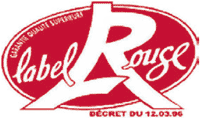
In the US, a grassroots pastured poultry movement has been growing since the early 1990s. Poultry raised on pasture are processed on-farm and direct marketed, creating supplemental income on small diversified family farms. See ATTRA's Alternative Poultry Production Systems and Outdoor Access for a description. The French Label Rouge, which also started out as a grassroots programme, provides an example of what is possible when farmers, consumers and organisations work together.
This article will cover Label Rouge production.
Production
Label Rouge began 40 years ago as a grassroots movement led by visionary farmers. As poultry became more industrialised after World War II, demand grew in France for the taste of traditionally raised farm chickens. Label Rouge performance has been called 'stunning' and now accounts for 30 per cent of poultry sales to the public, in spite of its high price – twice the price of conventional poultry (Westgren, 1999).
The Label Rouge programme focuses on high-quality products, mainly meat, with poultry as the flagship product. It emphasises quality attributes such as taste and food safety and free-range production practices. The average consumer can note a positive difference in taste between Label Rouge and conventional poultry – in fact, regular taste-testing is a certification requirement to prove that these products are 'vividly distinguishable' from conventional poultry, according to the programme.
The main reason for the superior taste is considered to be the use of slow-growing birds instead of the fast-growing birds used in the conventional industry. The slow-growing birds are from specialty rustic genetic stock and are harvested close to sexual maturity, The meat is flavoursome and firm, but not tough.
Standards
Strict and comprehensive standards ensure quality. Following are the standards related to broiler production.
Independent third-party certifying organisations ensure that standards are being followed. Inspection occurs once for each flock, twice a year for feed mills, monthly for processing plants and twice a year for hatcheries. Each visit includes bacteriology tests and process control inspections. There are five taste tests a year.
The standards are a base-line that many Label Rouge filieres surpass. For example, some groups:
- use dividers in the house to break down flocks into smaller groups
- require tree and bush plantings to integrate the house into the countryside as well as provide shade on pasture
- use smaller, portable houses
- do not permit pesticide use on the range
- require grit and whole grains to improve gut health, and
- maintain a constant ration to keep the taste of the birds constant, not changing it when other ingredients are less expensive.
Besides broilers, standards also exist for layers, turkeys, ducks, geese, guinea fowl and capons. Layers require double yards (rested in rotation) because they are on the range longer than broilers. The standards are available in French [click here]. There are also Label Rouge hams, sausages, eggs, rabbit and cheese products.
As is evident from this discussion of standards, a certification programme can permit much broader production claims than a mere definition can. In addition, production claims can be verified by the consumer.
| Table 1. Label Rouge standards for broiler production | |
|---|---|
| Genetics | Only certain genetics are allowed – slow growing breeds suited for outdoor production. |
| Buildings | Buildings are a maximum of 4,304 square feet. No farm can have more than four buildings. Building must be at least 98 feet from each other. |
| Maximum density in building |
The maximum stocking density is 0.98 square feet for a bird. No more than 4,400 birds are permitted in each building. Chickens require 2.2lb of litter each. |
| Access and size of range |
All birds have access to the outdoors from 09:00 until dusk after six weeks of age, and must be outside for at least 42 days of grow-out. Range requirements are 22 square feet per bird. About two acres of land are needed per house. 1.2 feet of pophole exits are required for 100 square feet of building. |
| Feed | Feed must consist of at least 75% cereal and must be non-medicated; starter rations can be 50% cereal because of a higher soybean ocntent. Rations cannot ocntian animal products, growth stimulants or other additives. Fishmeal is not permitted. Synthetic amino acids are allowed. |
| Other | Although routijne meidcations are not allowed, antibiotics prescribed by a veterinarian are. Coccidiostats are permitted but must be withdrawn five days before slaughter. Vaccination is allowed; beak and toe trimming are not. |
| Slaughter age | Birds must be grown a minimum 81 days. |
| Dressed weight | Minimum 2.2kg without giblets |
| Sanitation period | There is a minimum sanitation period of 21 days between flocks. |
| Transport | No more than two hours travelling time or 64 miles to processing plant |
| Processing | Air-chill |
| Shelf life | Sold fresh within nine days of slaughter |
| Chart adapted from François Paybou's Technical and Economic Feasibility Study of Adopting French Label Rouge Poultry Systems to Illionois (2000) | |
Case Studies: Lands Filiere and Loue Filiere
-->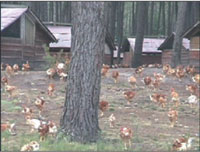
Photo: NCAT
The journey from a grassroots movement to an industry can be seen by studying two different filieres.
The Label Rouge movement began in the 1960s in the southwest of France, in the forested Landes region. Landes poultry are still known for being raised in a pine forest, using small portable housing called Marensines.
The size of the buildings ranges from 16 feet × 16 feet (256 square feet) to 20 feet × 33 feet (660 square feet). Older houses were built of wood; new ones are metal. In a dense forest, the smaller houses fit between the trees. Litter is spread in the houses, which are floorless. Brooding is done in the houses with gas brooders. Part of the feed is kept outside to help train birds to go out.
The houses are moved after every grow-out (three times a year) and have knobs where wheels can be attached and towed by tractor. The houses are sometimes placed beside corn-fields so that birds can benefit from shade and forage for insects. Often, only three sites on the farm are used in rotation. The sites have a water line or producers fill barrels, which feed water troughs, every couple of days.
You can read about the Landes filiere on its web site [click here]. There is an English-language option.
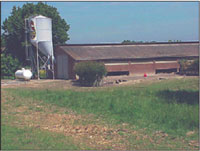
Photo: NCAT
George Berbille invented the portable Marensine system 40 years ago and is considered the father of range poultry production in France. His farm is in the southwest in the Landes filiere. He is now elderly and has lost a leg to a combine but still raises corn and poultry – 50,000 birds a year by himself. He has 20 small houses, which take two days to move with the help of three people. (The houses are dismantled before moving.) He also has an on-farm feedmill and mixes feed daily for his use and for sale.
Although Label Rouge production began in the Landes region, it was the Loue filiere that was instrumental in making it a viable industry. Label Rouge did not grow as an industry until the product became widely available at supermarkets.
Loue is now the largest filiere and represents the typical production system used – a small fixed house and yard. The house has automated feeding and watering equipment, and chicks are brooded in it. The house has several popholes that allow access to the range. There are shade bushes planted in the yard as well as tree plantings. The yard immediately outside the house is dirt. Since speciality rustic genetics are used, the birds forage well beyond the house and have access to grassy pasture. Feed and water are also provided outside. The Loue Web site [click here], is available in French only but has many informative pictures.
It is not necessary to use stationary housing in order to build a national industry. Pastured-poultry producers in the United States are keenly interested in pasture rotation and use portable houses. In adapting Label Rouge features, US producers are more likely to promote portable housing than stationary housing. However, small speciality companies may adapt a stationary system. Production systems are an excellent way to differentiate between companies in the marketplace, as long as the basic standards are followed to market under a common label.
Label Rouge birds are usually produced on diversified farms where they are integrated with other livestock and grain production. Bird rations are supplemented with whole grains from the farm; litter from the house is spread on the fields. Poultry may bring in 50 per cent of the farm income.
Although no fence is used in either the Loue or Landes filiere, the loss to predators is only one per cent. The United States, however, has more predator pressure. European Union (EU) definitions differentiate fenced and unfenced production systems:
- fenced – 'raised in open air'
- unfenced – 'raised in total freedom'
The Label Rouge programme permits both. The European Union specification 1538-91 defines Label Rouge as 'traditional free-range poultry'.
Genetics
-->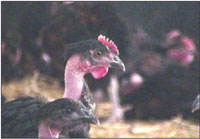
Photo: NCAT
Slow-growing birds are key in Label Rouge production – birds grow to five pounds in 12 weeks. In comparison, the fast-growing broilers (Cornish cross) of the conventional industry reach five pounds in six to seven weeks. Not only does slow growth allow the organs, muscle and bones to grow in harmony, it also results in a more flavoursome meat. The carcass is generally more elongated and has a smaller breast and larger legs than conventional carcasses. In addition, slower growing breeds are more suited to outdoor production than Cornish cross.
In Europe, the slow-growing genetics are mainly supplied by the poultry breeding companies SASS0 and Hubbard. The companies do not sell the actual broiler chicks, but rather the parents. However, many pastured poultry producers have hatching capability. SASSO's typical Label Rouge cross is T44N male × SA51 female (using a different male – the T44NI – results in white under-feathers in the offspring). A typical Hubbard cross is S77N male × JA57 female. Broilers from both of these crosses will have red feathers, yellow shanks, thin skin and a naked neck. Other parents are available for broilers with white feathers and skin, black feathers, barred, non-naked neck and more or for faster growth.
Health
The use of slow-growing genetics and the low-density Label Rouge production system offer distinct health advantages – ascites, leg problems and sudden death are minimal, and birds have good immunity. Mortality for conventional broilers in France is six per cent during a six-week grow-out; it is half that for Label Rouge production (three per cent) even during a much longer grow-out of 12 weeks (Faure, 2002).
Since Label Rouge birds have a longer life, they have a different vaccination schedule from conventional broilers. For example, in France, conventional broilers are not vaccinated for Marek's Disease; Label Rouge broilers are vaccinated. Label Rouge birds are generally vaccinated for coccidiosis and given de-wormers in the feed. Probiotics are used; antibiotics can be used only if prescribed by a veterinarian. Regular biosecurity on the farm is important – foot-baths are used at the entry-ways to houses and visitors must wear protective clothing.
Since France has a mild climate, birds are raised outdoors However, the mean number of flocks per year is only 3.2 because the grow-out is long and there is a long downtime required between flocks for proper sanitation and pasture rest.
Feeding
A low-protein and low-calorie diet is used for slow-growing birds. Whereas typical fast-growing Cornish-cross rations in the industry start at 22 per cent crude protein and finish at 17 per cent protein, Label Rouge rations start at only 20 per cent protein and finish at 15 per cent. According to Jeff Mattocks of Fertrell, pastured poultry producers in the United States often use one ration of 19 per cent protein. A low-protein ration is used to slow down the rapid growth of Cornish cross. This type of ration could easily be used for slow-growing genetics. For more information on poultry nutrition, Jeff Mattocks's publication Pastured Poultry Nutrition, can be requested through ATTRA.
All meat meal is banned from livestock feed in Europe. Even fishmeal is not permitted in Label Rouge production because it could be confused with meat meal. Only vegetable fat is permitted and no genetically engineered crops can be used in feed.
Some feed mills in France are dedicated to the eradication of salmonella in feed. At Landal, a feed mill in the southwest that supplies feed to the Landes company, entering trucks must be disinfected and high heat is used during milling to kill pathogens.
Processing
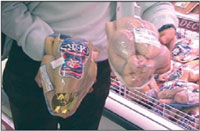
Photo: NCAT
Some processing plants exclusively process Label Rouge products; for others, Label Rouge is only a percentage of their work. There are several large automated Label Rouge plants – for example, Fermier Landes processes 200,000 birds a week – as well as small ones. There are many quality control points during Label Rouge processing to ensure a high-quality carcass. Processing plants in France cool carcasses by air chilling instead of immersion chilling. In immersion chilling, the carcasses soak up water. A soft scald is used instead of the hard scald typical in the United States. A soft scald uses a lower temperature for a longer time than a hard scald and keeps the skin intact.
Although ready-to-cook products are the most common, a variety of dressing methods are used. In the 'efilee' style, the bird is eviscerated but the crop, head and feet are left intact. Corn finishing is a part of this presentation. The customer should be able to feel whole grains still in the crop. Birds dressed in this style are slaughtered and eviscerated manually.
Processing plants may also handle a variety of species. For example, Fermier Landes processes chickens, guinea fowl, cockerels and rabbits, as well as capons and turkeys from Christmas. Although it is a large plant, it can put together small custom orders for butchers and other clients.
The second part of this publication, describing the organisation of the Label Rouge system, will follow next week.
February 2011








